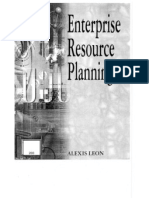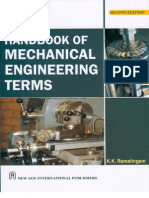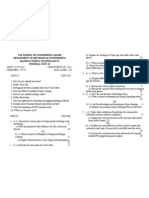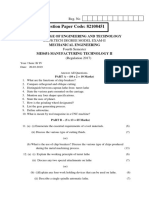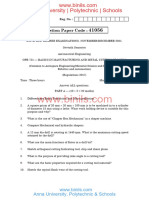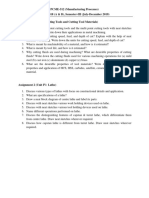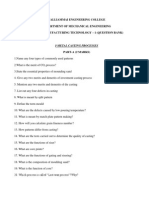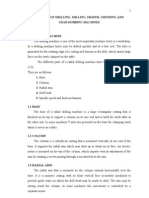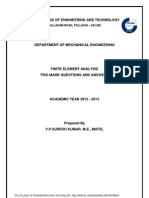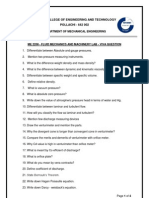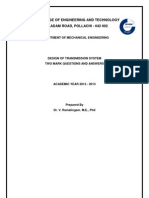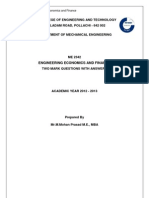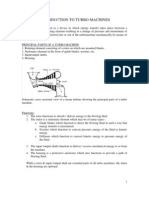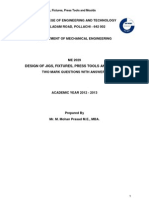Kings: Me1252-Manufacturing Technology - Ii
Kings: Me1252-Manufacturing Technology - Ii
Uploaded by
Mohan Prasad.MCopyright:
Available Formats
Kings: Me1252-Manufacturing Technology - Ii
Kings: Me1252-Manufacturing Technology - Ii
Uploaded by
Mohan Prasad.MOriginal Title
Copyright
Available Formats
Share this document
Did you find this document useful?
Is this content inappropriate?
Copyright:
Available Formats
Kings: Me1252-Manufacturing Technology - Ii
Kings: Me1252-Manufacturing Technology - Ii
Uploaded by
Mohan Prasad.MCopyright:
Available Formats
ME1252-MANUFACTURING TECHNOLOGY - II
KINGS
COLLEGE OF ENGINEERING
DEPARTMENT OF MECHANICAL ENGINEERING
QUESTION BANK
Subject Name: ME1252-MANUFACTURING TECHNOLOGY-II Year/Sem: II / IV
UNIT-I THEORY OF METAL CUTTING
PART-A (2 MARKS)
1. What is tool signature?
2. What is side rake angle? And mention its effects?
3. What is clearance angle? And mention its types?
4. Explain the nose radius.
5. What is function of chip breakers?
6. Name the factors that contributes to poor surface finish in cutting.
7. What is orthogonal cutting?
8. What are the functions of cutting fluids?
9. Give two examples for orthogonal cutting.
10. What are the four important characteristics of materials used for cutting tools?
11. List the characteristics of cutting fluid.
12. Name the various cutting tool materials.
PART-B (16 MARKS )
1. Explain orthogonal cutting and oblique cutting with its neat sketches and
compare. (16)
2. What is orthogonal rake system? Show the ORS of tool analysis with the help of
a sketch. (16)
3. what is the use of a chip breaker? Discuss the various types of chips produced
during metal machining process. (16)
4. Explain the condition that promote the formation of the following types of chip.
i) Continuous chips without built up edge. (5)
ii) Continuous chips with built up edge. (5)
iii) Discontinuous chips. (6)
KINGS COLLEGE OF ENGINEERING PAGE NO.1/7
ME1252-MANUFACTURING TECHNOLOGY - II
5. i) Define the various tool parts of a single point cutting tool with a neat sketch.
(6)
ii) What are the standard angles of cutting tool? Illustrate with an example.
(10)
6. Explain the expected properties and purposes of cutting fluids. Also mention the
various types of cutting fluids. (16)
7. i) What are the various forms of wear found in cutting tools? Show with a neat
sketch. (6)
ii) How do the cutting process parameters affect the cutting tool wear in single
point tools? (10)
8. i) Derive the expression for shear angle in orthogonal cutting in terms of rake
angle and chip thickness ratio. (6)
ii) How do you define tool life? Explain the parameters that control the tool life of
a single point cutting tool. (10)
9. What is the tool life equation and state the factor affecting the tool life. (16)
10. i) What is machinability? And explain. (8)
ii) Explain the various tool materials. (8)
11. i) Write short notes on surface finish. (5)
ii) What are the different type of cutting fluids used in machining process. (5)
iii) Write short notes tool wear. (6)
UNIT-II CENTRE LATHE & SPECIAL PURPOSE LATHES
PART-A (2 MARKS)
1. What is swing diameter?
2. Write the specification of a typical lathe.
3. Write down the names of any four lathe accessories.
4. What is the application of air operated chuck?
5. Define the term ‘Conicity”.
6. Write down the formula for calculating taper turning angle by compound rest
method.
7. Define the term ‘Thread cutting’.
8. Define automatic machine.
9. State the principal of multi spindle automats.
10. What are the advantages of automatic lathes?
KINGS COLLEGE OF ENGINEERING PAGE NO.2/7
ME1252-MANUFACTURING TECHNOLOGY - II
`PART-B (16 MARKS )
1. What are the various methods available for taper turning in a lathe? Explain their
specific advantages and limitations. (16)
2. Give a sketch illustrating the principle of operation of the Swiss-type automatic.
(16)
3. i) write down the differences between a capstan and a turret lathe. (8)
ii) Explain with a neat sketch the working of a Swiss type automatic lathe. (8)
4. i) Describe some of the methods and equipments for holding work on a lathe.
(8)
ii) Explain any four commonly used attachments on lathe. (8)
5. i) Briefly explain the principle of working of the sliding head type single spindle
automatic machine. (8)
ii) Describe with a neat sketch a turret automatic screw machine. (8)
6. Sketch and explain the function apron mechanism available in lathe. (16)
7. Explain the principal parts of a capstan lathe with a neat sketch and list out the
differences between a capstan and a turret lathe. (16)
8. List various type of feed mechanisms and explain briefly about tumbler gear
reversing mechanism with a sketch. (16)
9. Explain the tooling layout for the production of a Hexagonal bolt in a capstan
lathe. (16)
10. Discuss the tooling layout for the production of a Hexagonal nut in Turret lathe.
(16)
11. i) Describe a typical single spindle automatic chucking machine. (8)
ii) Describe a typical single spindle automatic bar machine. (8)
12. Differentiate between parallel action and progressive action multi-spindle
automatics. (16)
UNIT-III OTHER MACHINE TOOLS
PART-A (2 MARKS)
1. Write down any four operations performed by a shaper.
2. Define feed and depth of cut.
3. What is the function of clapper block in a planner?
4. What is meant by up milling and down milling?
5. Define “Face milling “.
KINGS COLLEGE OF ENGINEERING PAGE NO.3/7
ME1252-MANUFACTURING TECHNOLOGY - II
6. Write down the rule for gear ratio in differential indexing.
7. How do you specify radial drilling machine.
8. Write down any four operations performed by a drilling machine.
9. What is meant by “Sensitive hand feed”?
10. Calculate the tap drill size to cut an internal thread for bolt of outside diameter
10mm,pitch 1.5mm and depth of the thread 0.61 pitch ?
PART-B (16 MARKS )
1. i) Compare a shaper and planer in terms of their operation and type of work
pieces. (6)
ii) Write a small note on slotting machines. (10)
2. What are the differences between compound indexing and differential indexing?
Explain the relative merits. (16)
3. i) State the advantages of Ward-Leonard drive. (6)
ii) Explain with a sketch "Fast and Loose pulleys" quick return mechanism
of a planer table. (10)
4. i) Explain the methods of holding milling cutters. (4)
ii) Explain Simple indexing, Compound indexing and differential indexing with
suitable example. (12)
5. With a simple sketch, explain the working of the crank and slotted link quick
return motion mechanism used in shaper. (16)
6. With neat sketches, explain any two of the work holding devices commonly used
for holding the work in a drilling machine. (16)
7. Explain the hydraulic drive of a horizondal shaper with neat sketches. (16)
8. i) sketch a twist drill. Write down its main parts and their functions. (10)
ii) Write short notes on reaming and boring operations. (6)
9. i) Write down any four differences between shaper and planer. (6)
ii) Explain the Working principle of planer with a neat sketch. (10)
10. Describe the working mechanism of a universal dividing head, with neat
diagram. (16)
11. With a simple sketch, explain the principal parts and angles of a plain milling
cutter .Explain them . (16)
12. Explain the twist drill nomenclature and define various elements of twist drill.
(16)
13. With a simple sketch, explain the working of a vertical boring machine. (16)
14. Explain the Working principle of a Jig boring machine with a neat sketch.(16)
KINGS COLLEGE OF ENGINEERING PAGE NO.4/7
ME1252-MANUFACTURING TECHNOLOGY - II
UNIT-IV ABRASIVE PROCESSES & GEAR CUTTING
PART-A (2 MARKS)
1. What is the process of self-sharpening of the grinding wheel?
2. What are the four movements in a cylindrical centre type grinding?
3. What is meant by centreless grinding?
4. Define the terms abrasive grains.
5. What is meant by grit or grains size?
6. Define the term grade used in grinding wheel.
7. What do you mean by loading of grinding wheels?
8. What is meant by dressing and truing?
9. What is meant by honing?
10. What is super finishing?
PART-B (16 MARKS )
1. i) With a simple sketch explain the way of dressing a grinding wheel and
mention its necessity. (8)
ii) Sketch and explain the cylindrical grinding operation. (8)
2. i) Explain the honing process with a sketch. (6)
ii) Sketch and explain a gear shaping machine. (10)
3. Explain the external cylindrical grinding process and surface grinding process.
(16)
4. Explain with neat sketches the following operations: Honing, Lapping,
Superfinishing and buffering. (16)
5. With the help of neat sketch, discuss the working of continuous surface
broaching machine and write its advantages and limititions. (16)
6. i) Compare gear hobbing with gear shaping. (8)
ii) State the advantages and limitations of broaching. (8)
7. i) Explain self-sharpening characteristics of grinding wheel. (5)
ii) Describe the use of cutting fluids in grinding. (5)
iii)Explain wheel truing and dressing. (6)
8. Describe a grinding wheel structure with the help of a neat sketch and state
different bonding and abrasive materials used in it. What would you like as an
abrasive for grinding steel? (16)
9. Compare gear shaping and gear hobbing, giving the process and product
requirements. (16)
KINGS COLLEGE OF ENGINEERING PAGE NO.5/7
ME1252-MANUFACTURING TECHNOLOGY - II
10.i) Explain the vitrified and resinoid bonding process. (6)
ii) Explain the operations of horizontal broaching machine with neat sketch.
(10)
11.i) Explain the gear cutting by a formed tool. (8)
ii) Differentiate between gear forming and generating. (8)
12.What are the various methods of centerless grinding and explain each briefly?
(16)
UNIT-V CNC MACHINE TOOLS & PART PROGRAMMING
PART-A (2 MARKS)
1. State the advantages of NC machines.
2. What is point-to point (PPT) system?
3. Mention the main difference between CNC and DNC.
4. What is the function of servo valve?
5. Define absolute and incremental programming.
6. What are the important steps to be followed while preparing part programming?
7. What is meant by MACRO?
8. Define subroutine.
9. What do mean by canned cycle?
10. What is meant by APT programme?
PART-B (16 MARKS )
1. i) State a few typical applications where the use of numerical control would be
justified. (8)
ii) Describe in brief the basic components of a tape-operated NC machine tool.
(8)
2. i) Discuss the advantages of computer numerical control system. (8)
ii) What is the difference between positioning machines and contouring
machines? (8)
3. Describe the main features of CNC machines, which distinguish them from
conventional machine tools. (16)
4. i) How is cutter compensation given in the case of a machining centre? Explain it
with an example. (8)
ii) Describe the functions of a post processor. (8)
5. Define CNC and DNC. With a help of a diagram explain the working of NC
machine tool. (16)
6. i) How is manual programming of a NC machine done? (8)
KINGS COLLEGE OF ENGINEERING PAGE NO.6/7
ME1252-MANUFACTURING TECHNOLOGY - II
ii) Write short notes on APT language. (8)
7. i) Discuss in detail about the design considerations of CNC machines for
improving machining accuracy. (8)
ii) write a note on spindle drives and feed drives of CNC machines. (8)
8. Sketch and explain a turning centre and mention its superiority over the CNC
lathe. (16)
9. Explain the part programming procedure with a good example. (16)
10. List and explain G and M code for turning milling operations. (16)
KINGS COLLEGE OF ENGINEERING PAGE NO.7/7
You might also like
- ME2257 Computer Aided Machine Drawing Manual100% (1)ME2257 Computer Aided Machine Drawing Manual60 pages
- ME2257 Computer Aided Machine Drawing Manual100% (1)ME2257 Computer Aided Machine Drawing Manual60 pages
- Enterprise Resource Planning by Alexis Leon (Mohit)100% (1)Enterprise Resource Planning by Alexis Leon (Mohit)322 pages
- Heat and Mass Transfer - 2 Marks - All 5 Units100% (4)Heat and Mass Transfer - 2 Marks - All 5 Units16 pages
- Me2252 Manufacturing Technology II r8 April - May 2010No ratings yetMe2252 Manufacturing Technology II r8 April - May 20102 pages
- Vsa School of Engineering, Salem Department of Mechanical Engineering Manufacturing Technology Ii Internal Test-IiNo ratings yetVsa School of Engineering, Salem Department of Mechanical Engineering Manufacturing Technology Ii Internal Test-Ii1 page
- Department of Mechanical Engineering Question Bank M E6402 M A N U F A CTU R ING Technolo G Y - IiNo ratings yetDepartment of Mechanical Engineering Question Bank M E6402 M A N U F A CTU R ING Technolo G Y - Ii10 pages
- Periyar Centenary Polytechnic Collage Manufacturing Technology - II Subcode: Meb520No ratings yetPeriyar Centenary Polytechnic Collage Manufacturing Technology - II Subcode: Meb5205 pages
- Design of Jigs, Fixtures and Press Tools - Department of Mechanical Engineering100% (2)Design of Jigs, Fixtures and Press Tools - Department of Mechanical Engineering8 pages
- G.Hraisoni College of Engineering, NagpurNo ratings yetG.Hraisoni College of Engineering, Nagpur7 pages
- B-Tech. Mechanical UNIT-1: Bme 206 Manufacturing Technology - 1No ratings yetB-Tech. Mechanical UNIT-1: Bme 206 Manufacturing Technology - 16 pages
- Dhanalakshmi College of Engineering Department of Mechanical Engineering Me 6302 Manufacturing Technology - 1 (Question Bank)No ratings yetDhanalakshmi College of Engineering Department of Mechanical Engineering Me 6302 Manufacturing Technology - 1 (Question Bank)10 pages
- Fourth Semester Diploma Examination in Mechanical Engineering/TechnologyNo ratings yetFourth Semester Diploma Examination in Mechanical Engineering/Technology2 pages
- Answer Any Five Questions From Section-BNo ratings yetAnswer Any Five Questions From Section-B1 page
- How to Run a Lathe - Volume I (Edition 43) The Care and Operation of a Screw-Cutting LatheFrom EverandHow to Run a Lathe - Volume I (Edition 43) The Care and Operation of a Screw-Cutting Lathe4.5/5 (2)
- Prompting Science and Engineering Students in Practical TrigonometryFrom EverandPrompting Science and Engineering Students in Practical TrigonometryNo ratings yet
- Sl. No. Name of The Programme Faculty of Civil Engineering: Regulations 2013No ratings yetSl. No. Name of The Programme Faculty of Civil Engineering: Regulations 20132 pages
- Engineering Metrology and Measurement - 2 Marks - All 5 Units92% (13)Engineering Metrology and Measurement - 2 Marks - All 5 Units21 pages
- Power Plant Engineering - 2 Marks - All 5 Units89% (9)Power Plant Engineering - 2 Marks - All 5 Units25 pages
- Finite Element Analysis - 2 Marks - All 5 Units77% (31)Finite Element Analysis - 2 Marks - All 5 Units13 pages
- Gas Dynamics and Jet Propulsion - 2 Marks - All 5 Units80% (10)Gas Dynamics and Jet Propulsion - 2 Marks - All 5 Units22 pages
- ME 2207 - Manufacturing Technology 1 - Lab Manual71% (17)ME 2207 - Manufacturing Technology 1 - Lab Manual57 pages
- ME 2208 Fluid Mechanics and Machinery Lab - Viva Question100% (5)ME 2208 Fluid Mechanics and Machinery Lab - Viva Question4 pages
- Design of Transmission System - 2 Marks - All 5 Units80% (15)Design of Transmission System - 2 Marks - All 5 Units20 pages
- Engineering Economics and Finance - 2 Marks - All 5 Units100% (2)Engineering Economics and Finance - 2 Marks - All 5 Units16 pages
- Dynamics of Machinery - 2 Marks - All 5 Units58% (12)Dynamics of Machinery - 2 Marks - All 5 Units13 pages
- Composite Materials - 2 Marks - All 5 Units85% (20)Composite Materials - 2 Marks - All 5 Units31 pages
- Fluid Mechanics - Lecture Notes - Unit 4No ratings yetFluid Mechanics - Lecture Notes - Unit 471 pages
- Design of Jigs and Fixtures - 2 Marks - All 5 Units100% (1)Design of Jigs and Fixtures - 2 Marks - All 5 Units16 pages
- Strength of Materials - 2 Marks - All 5 Units90% (39)Strength of Materials - 2 Marks - All 5 Units27 pages
- Kinematics of Machinery - 2 Marks - All 5 Units94% (16)Kinematics of Machinery - 2 Marks - All 5 Units18 pages
- Fluid Mechanics and Machinery - 2 Marks - All 5 Units94% (18)Fluid Mechanics and Machinery - 2 Marks - All 5 Units24 pages
- Computer Aided Manufacturing - 2 Marks - All 5 Units67% (6)Computer Aided Manufacturing - 2 Marks - All 5 Units18 pages
- Enterprise Resource Planning by Alexis Leon (Mohit)Enterprise Resource Planning by Alexis Leon (Mohit)
- Me2252 Manufacturing Technology II r8 April - May 2010Me2252 Manufacturing Technology II r8 April - May 2010
- Vsa School of Engineering, Salem Department of Mechanical Engineering Manufacturing Technology Ii Internal Test-IiVsa School of Engineering, Salem Department of Mechanical Engineering Manufacturing Technology Ii Internal Test-Ii
- Department of Mechanical Engineering Question Bank M E6402 M A N U F A CTU R ING Technolo G Y - IiDepartment of Mechanical Engineering Question Bank M E6402 M A N U F A CTU R ING Technolo G Y - Ii
- Periyar Centenary Polytechnic Collage Manufacturing Technology - II Subcode: Meb520Periyar Centenary Polytechnic Collage Manufacturing Technology - II Subcode: Meb520
- Design of Jigs, Fixtures and Press Tools - Department of Mechanical EngineeringDesign of Jigs, Fixtures and Press Tools - Department of Mechanical Engineering
- B-Tech. Mechanical UNIT-1: Bme 206 Manufacturing Technology - 1B-Tech. Mechanical UNIT-1: Bme 206 Manufacturing Technology - 1
- Dhanalakshmi College of Engineering Department of Mechanical Engineering Me 6302 Manufacturing Technology - 1 (Question Bank)Dhanalakshmi College of Engineering Department of Mechanical Engineering Me 6302 Manufacturing Technology - 1 (Question Bank)
- Fourth Semester Diploma Examination in Mechanical Engineering/TechnologyFourth Semester Diploma Examination in Mechanical Engineering/Technology
- How to Run a Lathe - Volume I (Edition 43) The Care and Operation of a Screw-Cutting LatheFrom EverandHow to Run a Lathe - Volume I (Edition 43) The Care and Operation of a Screw-Cutting Lathe
- Prompting Science and Engineering Students in Practical TrigonometryFrom EverandPrompting Science and Engineering Students in Practical Trigonometry
- Sl. No. Name of The Programme Faculty of Civil Engineering: Regulations 2013Sl. No. Name of The Programme Faculty of Civil Engineering: Regulations 2013
- Engineering Metrology and Measurement - 2 Marks - All 5 UnitsEngineering Metrology and Measurement - 2 Marks - All 5 Units
- Gas Dynamics and Jet Propulsion - 2 Marks - All 5 UnitsGas Dynamics and Jet Propulsion - 2 Marks - All 5 Units
- ME 2208 Fluid Mechanics and Machinery Lab - Viva QuestionME 2208 Fluid Mechanics and Machinery Lab - Viva Question
- Design of Transmission System - 2 Marks - All 5 UnitsDesign of Transmission System - 2 Marks - All 5 Units
- Engineering Economics and Finance - 2 Marks - All 5 UnitsEngineering Economics and Finance - 2 Marks - All 5 Units
- Design of Jigs and Fixtures - 2 Marks - All 5 UnitsDesign of Jigs and Fixtures - 2 Marks - All 5 Units
- Fluid Mechanics and Machinery - 2 Marks - All 5 UnitsFluid Mechanics and Machinery - 2 Marks - All 5 Units
- Computer Aided Manufacturing - 2 Marks - All 5 UnitsComputer Aided Manufacturing - 2 Marks - All 5 Units

